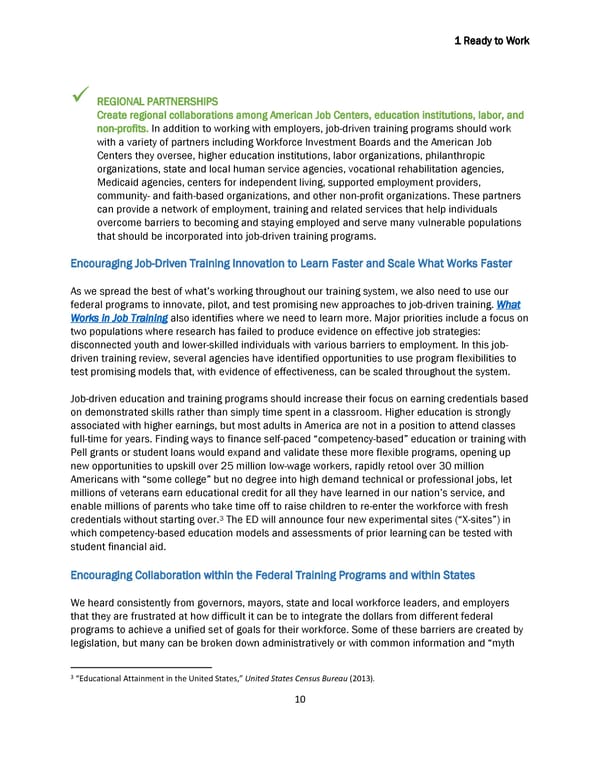1 Ready to Work REGIONAL PARTNERSHIPS Create regional collaborations among American Job Centers, education institutions, labor, and non-profits. In addition to working with employers, job-driven training programs should work with a variety of partners including Workforce Investment Boards and the American Job Centers they oversee, higher education institutions, labor organizations, philanthropic organizations, state and local human service agencies, vocational rehabilitation agencies, Medicaid agencies, centers for independent living, supported employment providers, community- and faith-based organizations, and other non-profit organizations. These partners can provide a network of employment, training and related services that help individuals overcome barriers to becoming and staying employed and serve many vulnerable populations that should be incorporated into job-driven training programs. Encouraging Job-Driven Training Innovation to Learn Faster and Scale What Works Faster As we spread the best of what’s working throughout our training system, we also need to use our federal programs to innovate, pilot, and test promising new approaches to job-driven training. What Works in Job Training also identifies where we need to learn more. Major priorities include a focus on two populations where research has failed to produce evidence on effective job strategies: disconnected youth and lower-skilled individuals with various barriers to employment. In this job- driven training review, several agencies have identified opportunities to use program flexibilities to test promising models that, with evidence of effectiveness, can be scaled throughout the system. Job-driven education and training programs should increase their focus on earning credentials based on demonstrated skills rather than simply time spent in a classroom. Higher education is strongly associated with higher earnings, but most adults in America are not in a position to attend classes full-time for years. Finding ways to finance self-paced “competency-based” education or training with Pell grants or student loans would expand and validate these more flexible programs, opening up new opportunities to upskill over 25 million low-wage workers, rapidly retool over 30 million Americans with “some college” but no degree into high demand technical or professional jobs, let millions of veterans earn educational credit for all they have learned in our nation’s service, and enable millions of parents who take time off to raise children to re-enter the workforce with fresh credentials without starting over.3 The ED will announce four new experimental sites (“X-sites”) in which competency-based education models and assessments of prior learning can be tested with student financial aid. Encouraging Collaboration within the Federal Training Programs and within States We heard consistently from governors, mayors, state and local workforce leaders, and employers that they are frustrated at how difficult it can be to integrate the dollars from different federal programs to achieve a unified set of goals for their workforce. Some of these barriers are created by legislation, but many can be broken down administratively or with common information and “myth 3 “Educational Attainment in the United States,” United States Census Bureau (2013). 10
 Biden Ready to Work White Paper 7/22/14 Page 9 Page 11
Biden Ready to Work White Paper 7/22/14 Page 9 Page 11